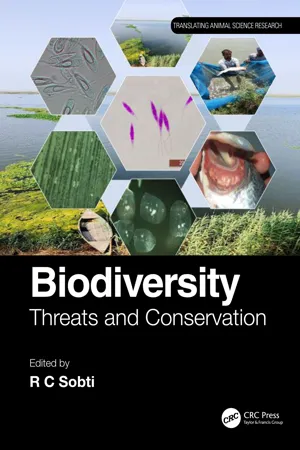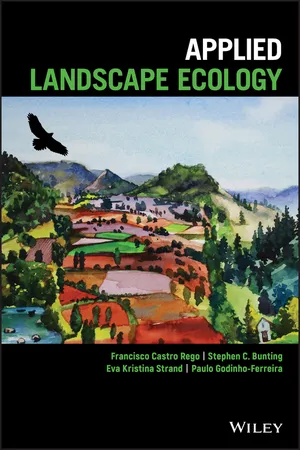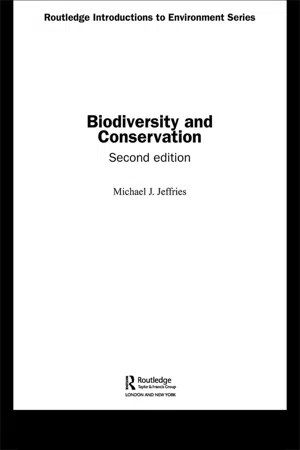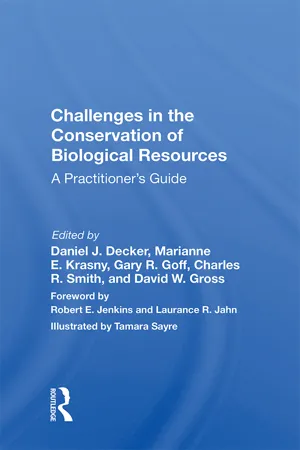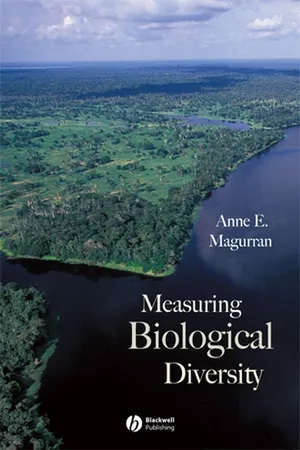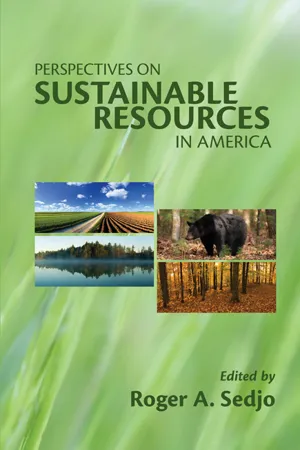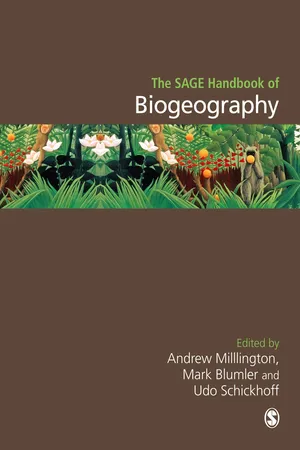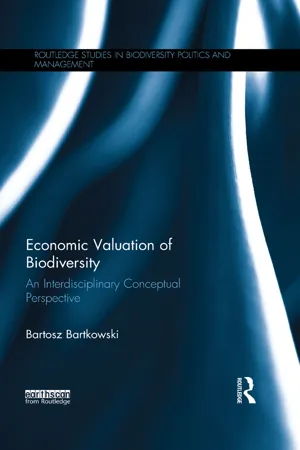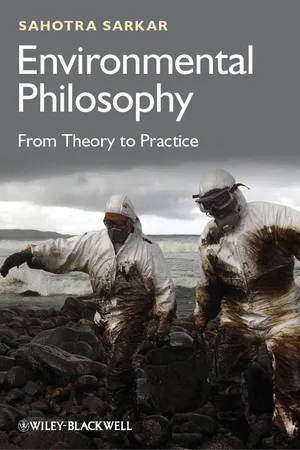Biological Sciences
Species Diversity
Species diversity refers to the variety of different species within a specific ecosystem or geographical area. It encompasses both the number of species present and their relative abundance. High species diversity is indicative of a healthy and resilient ecosystem, as it can provide a wider range of ecological services and contribute to overall ecosystem stability.
Written by Perlego with AI-assistance
Related key terms
Related key terms
1 of 4
Related key terms
1 of 3
10 Key excerpts on "Species Diversity"
- eBook - ePub
Biodiversity
Threats and Conservation
- R C Sobti, R C Sobti(Authors)
- 2022(Publication Date)
- CRC Press(Publisher)
In other words, it is the biological variety and variability of life on Earth and is a measure of variation at the genetic, species, and ecosystem levels. Biodiversity is the basis of all ecosystem services that provide supporting, provisioning, regulating, and cultural services and to which human well-being is intimately linked. No feature of Earth is more complex, dynamic, and varied than the biosphere that occupies its surfaces and its seas, but no feature is experiencing more dramatic change due to anthropogenic activities. Biodiversity plays a very important role in maintaining natural cycle and ecological balance, besides forming the basis of existence, human wealth, and preservation of nature on the Earth. It actually describes the biological capital held within an area and refers particularly to the differences between living organisms at different levels of biological organization—gene, individual, species, and ecosystem. Biodiversity encompasses multiple values and is vital for the production of food and conservation of the ecological foundations needed to sustain people’s livelihood. Biological diversity is often understood at three levels: Species Diversity refers to the variety of different species. Genetic diversity corresponds to the variety of genes contained in plants, animals, fungi, and microorganisms. Ecosystem diversity refers to all the different habitats that exist—tropical and temperate forests, hot and cold deserts, wetlands, rivers, mountains, coral reefs, and so on (Yucel, 2015). 25.1.1 Species Diversity Species Diversity is the variety of species within a habitat or a region. Species are the basic units of biological classification and thus the normal measure of biological diversity. Species richness is the term that describes the number of different species in a given area (Naughton-Treves et al., 2005) - eBook - ePub
- Francisco Castro Rego, Stephen C. Bunting, Eva Kristina Strand, Paulo Godinho-Ferreira(Authors)
- 2018(Publication Date)
- Wiley(Publisher)
7 Landscape Composition, Diversity, and Habitat SelectionDiversity is a key concept for all ecological studies. At the landscape scale diversity often refers to the composition of the landscape, that is, the number and the proportions of the various classes or types of habitat present in that landscape. However, diversity is also often a measure of the variety of species and their proportions. Biodiversity is now defined1 as “the variety of life on Earth, including all organisms, species, and populations, the genetic variation among these, and their complex assemblages of communities and ecosystems. It also refers to the interrelatedness of genes, species, and ecosystems and in turn, their interactions with the environment”.Because of the complexity of the issue and the possible difficulties and confusion in the use of the term Diversity, it is important to start by presenting the various measurements of diversity and then the relationships between these various types of diversity, from the Species Diversity of habitats and landscapes to the habitat selection and habitat use diversity of the species.7.1 Measurements of Diversity
Early civilization humans have attempted to describe the diversity of life (Figure 7.1 ). Biodiversity can be considered at different levels, from genes to species and from communities and habitats to landscapes. Interestingly, the same diversity measurements apply along the different levels of the ecological hierarchy. However, for simplicity, the initial measurements of diversity focused on the number of species found within a given area.Ancient Egyptian hieroglyphs showing a diversity of plant and animal symbols.Figure 7.1Source: http://previews.123rf.com/images/ddart/ddart1105/ddart110500001/9532981‐Ancient‐Egyptian‐hieroglyphs‐Stock‐Vector‐egyptian‐egypt‐hieroglyphics.jpg .Species richness (S - eBook - ePub
- Michael J. Jeffries(Author)
- 2006(Publication Date)
- Routledge(Publisher)
concept with species defined as the smallest population (sexual) or lineage (asexual) diagnostically distinct from other such populations and with a discrete lineage. The diagnostic characters are often genetic. When applied to species recognised by morphological or biological concept criteria, the sheer genetic diversity within species often suggests they should be splintered into many separate lineages. The evolutionary concept defines a species by a single, distinct lineage with an identifiable evolutionary history and fate.Ecological diversity
Taxonomic diversity classifies types of organisms and their relatedness but organisms do not live in isolation from one another or the physical world. Humans have long recognised different ecosystems of apparently interdependent life. Ecological science focuses on these patterns and processes, hence ecological diversity is the inclusive term for this third category.Ecological diversity covers a host of concepts; ecosystems, communities, assemblages, habitats, biomes and biogeographical regions. These are not one and the same, indeed some may not be biodiversity proper. The term ecosystem embraces the living organisms and non-living (abiotic) features such as climate and geology of a site. Some have argued that the inclusion of abiotic components excludes ecosystems from biodiversity. A community refers to organisms living together, essentially the live component of an ecosystem. Again this deceptively simple idea is problematic. The term implies a linkage, an interdependence of species that may not exist. Even tightly linked communities will harbour fleeting tourist species, moving through without necessarily playing any role whilst other communities may be very loosely tied assortments, often described as an assemblage. Habitat conjures up precise images such as the giant panda habitat, but the term may not mean anything if the species is not present; does giant panda habitat cease to exist should the giant panda become extinct? Biome is the term associated with global or continental scale, regional ecosystems defined by vegetation and fauna, in its turn largely determined by climate. A formation - eBook - ePub
Challenges In The Conservation Of Biological Resources
A Practitioner's Guide
- Daniel J. Decker(Author)
- 2019(Publication Date)
- Routledge(Publisher)
The conservation and management of biological resources have recently entered a period of uncharacteristic change. After decades of isolated refinement of management policies and practices within narrow, traditionally defined disciplines—such as land-use planning, agriculture, silviculture, fishery management, wildlife management—the broader, interdisciplinary field of conservation is now providing a new synthetic vision in which these often isolated, specialized fields work together to achieve broad, ecosystem-level goals. Such systemwide goals have taken a surprisingly long time to emerge, by consensus, from the sometimes conflicting goals of managers of different resources. Among the broad goals that have emerged, preserving biological diversity appears to be common to a new, unified mission for biological resource conservationists and managers.Biological diversity (or biodiversity) refers to the variety among living organisms and the complexity of the ecological systems in which they live. Diversity is defined by the number of different types of items in a system and the relative frequency of these different types. Biodiversity encompasses genetic diversity, Species Diversity, and ecosystem diversity (Fig. 4.1 ). Genetic diversity is the variation in genetic composition within and among species. It is composed of the various genes and alleles that exist within and among different populations and species. Species Diversity is the variety of different species found in an area, including the distribution and abundance of species. Ecosystem diversity is the variety of physical environments and biotic communities in an area. It represents the heterogeneity or patchiness of natural environments on scales from local to regional to global.This new focus on preserving biological diversity as a common goal for resource managers has stimulated much thoughtful self-examination of conservation's mission within the professional journals of the traditional natural resource fields (e.g., Wildlife Society Bulletin - eBook - ePub
- Anne E. Magurran(Author)
- 2013(Publication Date)
- Wiley-Blackwell(Publisher)
Figure 1.2 ).The definition of biological diversity I have adopted for the book is simply “the variety and abundance of species in a defined unit of study.” My goal is to evaluate the methods used to describe this diversity. I focus on species because they are the common currency of diversity. The first question that people ask is usually something like “how many species of trees are found in Costa Rica?” or “how many beetles are there in England’s New Forest?” or even “how many species are there on the earth?” This focus does not preclude measures that involve phylogentic information, which must in any case be weighted by species richness. I include abundance because the relative importance of species is a significant topic in its own right, and also because relative abundance is implicitly, if not explicitly, involved in the estimation of species richness.Izsák and Papp (2000) make a distinction between measures of ecological diversity and measures of biodiversity. Measures of ecological diversity traditionally, but not invariably (see, for example, Pielou 1975; Magurran 1988), take account of the relative abundance of species. A familiar example is the Shannon index, discussed in depth in Chapter 4. This class of measures treats all species as equal (see the section below on the assumptions of biodiversity measurement). Newer measures typically ignore abundance differences between species, focusing instead on taxonomic differences. However, I find Izsák and Papp’s (2000) distinction artificial, not least because Pielou (1975), in her pioneering text on ecological diversity, considered ways of incorporating phylogenetic information into diversity measures. It is also of note that Warwick and Clarke’s (2001) taxonomic distinctness measure—one of the most promising new approaches—is a form of the Simpson index, and can be adapted to incorporate abundance data. I have therefore used the term “diversity measure” to cover all the methods reviewed in this book. - eBook - ePub
- Roger A. Professor Sedjo, Roger A. Professor Sedjo(Authors)
- 2010(Publication Date)
- Routledge(Publisher)
The number of species in a given area, known as species richness, is the simplest and arguably most commonly used measure of biodiversity. Species are the central unit in biodiversity studies and conservation, at least in part because ecosystems are hard to delimit and genes have until recently been difficult to count and identify. A species is the basic unit of organism classification. It is typically defined as a group of similar organisms that interbreed in nature or share a common, genetically distinct lineage of descent. However, each species consists of subspecies (i. e., geographical races), populations, and individuals, each possessing its own levels of genetic distinctiveness. A population is a geographically distinct group of individuals of a particular species. An evolutionarily significant unit (ESU) is a population or group of populations that is substantially reproductively isolated and is sufficiently genetically unique from other populations to make it an important evolutionary component of the species. Although biodiversity is often measured using species richness, practical species management and conservation efforts often target populations and ESUs rather than entire species. 2 Genetic diversity refers to genetic variation within species, both among distinct populations and among the individuals within a population. Genes are the chromosomal units that code for the unique morphological and biochemical characteristics of an organism and are passed down along generations of organisms. Variation arises from mutations in genes, and natural selection of these characteristics within a population is the primary mechanism of biological evolution. In sexually reproducing species, genetic diversity also comes from recombination that occurs when genes are exchanged. Ecosystem diversity refers to the variation within and between communities and their associations with the physical environment - eBook - ePub
- Andrew Millington, Mark Blumler, Udo Schickhoff, Andrew Millington, Mark Blumler, Udo Schickhoff(Authors)
- 2011(Publication Date)
- SAGE Publications Ltd(Publisher)
I begin this chapter by outlining some of the challenges that biodiversity presents, the history of diversity theory, scale issues, and theory development regarding community diversity. I then turn to the species-area relationship, which, along with biodiversity gradients (see Mutke, this volume), is the most pervasive and ubiquitous of biogeographical diversity patterns. I end with a brief discussion about recent attempts at theory reduction and unification and promising avenues for future research.3.2 THE DIVERSITY PUZZLEA thought experiment helps illustrate some of the difficulties that diversity poses. Imagine Darwin’s tangled bank: a small patch of habitat in a larger landscape. How much diversity does it harbor? The question begs others. What exactly do we mean by diversity and how do we measure it? Why is there not more of it, or less? How does it compare to other tangled banks elsewhere, and how does it change through time. Why?Most of the current literature on biodiversity is based on taxonomic counts, the simplest and most intuitive measure of diversity (Gaston and Spicer, 2004), but this is just one dimension of the phenomenon. The United Nations (1993: 147) Convention on Biological Diversity—arguably the most influential single policy document on the topic—defines it more broadly as “the variability among living organisms from all sources including, inter alia, terrestrial, marine and other aquatic ecosystems and the ecological complexes of which they are part; this includes diversity within species, between species and of ecosystems.”A full characterization of biodiversity by these criteria must account for all of the genetic, morphological, physiological, and functional variability occurring within the bank and link it to the nearby habitats, ecosystems, and regional ecological complexes. This is a tall order, and no natural habitat has ever been investigated at this level of depth and detail. Taxonomic counts, on the other hand, are readily gained, and species richness (the number of species in an area) in particular has become the standard accounting unit for diversity inventories and theory development. - eBook - ePub
Economic Valuation of Biodiversity
An Interdisciplinary Conceptual Perspective
- Bartosz Bartkowski(Author)
- 2017(Publication Date)
- Routledge(Publisher)
Accordingly, there exist many approaches to defining biodiversity, which encompasses numerous levels and dimensions, including Species Diversity, genetic diversity, ecosystem diversity, functional diversity. In Chapter 5 we will return to the issue of defining biodiversity. In addition to a presentation of various definitions and the difficulties related to defining biodiversity, it was shown in this chapter how biodiversity can be measured. This discussion will feed into numerous arguments further on in this book, including the critical evaluation of biodiversity proxies used in economic valuation studies and the attempt to provide some insights about how the conceptual framework to be developed in Chapter 5 can be coupled with empirical data. An important subject of this chapter was biodiversity’s ecological value. Building upon current ecological literature, it was shown that biodiversity is correlated with ecosystem functioning, particularly with ecosystem stability - eBook - ePub
Environmental Philosophy
From Theory to Practice
- Sahotra Sarkar(Author)
- 2011(Publication Date)
- Wiley-Blackwell(Publisher)
Let us return to the fundamental question: what is biodiversity? Even a cursory survey of professional papers or textbooks of conservation biology will reveal two canonical definitions; they will also reveal almost no research that uses these definitions. The canonical definitions are the following:1. Biodiversity refers to the variety of life at every level of structural, taxonomic, and functional organization.2. Biodiversity refers to diversity of genes (alleles), species, and ecosystems.Many conservation biologists, especially in moments of unbridled political advocacy, may endorse definition (1) but, if the term “biodiversity” is to reflect the practice of conservation biology, this definition is useless. Biodiversity, as Takacs has pointed out, becomes all of biology.24 It is absurd to think that we should—let alone that we can—protect all diversity of structure, taxonomy, and function. We would have to protect almost every biotic entity. Biodiversity conservation is not the only policy goal in any social context, and resources for it are obviously not unlimited. Consequently, biotic features must be prioritized and an adequate definition of “biodiversity” must reflect where a society's priorities lie with respect to the type of biological diversity that deserves the most attention. We cannot reasonably aim to protect every biotic entity, even in principle.Definition (2) was probably never intended to define “biodiversity” fully; rather, it was supposed to operationalize it in the sense that protecting these three categories would presumably protect most of what is intended to be captured by definition (1). The trouble is that it has been a rather unsuccessful operationalization: allelic diversity is almost impossible to estimate accurately or protect in natural populations; Species Diversity, if we really mean all species, including microbial species, is almost as intractable.In practice, conservation biologists work with either limited sets of taxa or ecosystem types (for instance, vegetation types). However, it is often unclear whether the choice of limited sets of taxa or ecosystem types is motivated by practical considerations of measuring biodiversity or whether it reflects what biodiversity is categorically supposed to be. It is important to introduce a critical distinction at this state: - Justin Garson, Anya Plutynski, Sahotra Sarkar, Justin Garson, Anya Plutynski, Sahotra Sarkar(Authors)
- 2016(Publication Date)
- Routledge(Publisher)
Some decisions may not be necessary for particular contexts; for example, in environmental ethics one might reasonably discuss the value of Species Diversity while remaining relatively open or pluralistic on taxonomic issues. In scientific contexts, of course, precise definition and operationalization are crucial for formulating testable hypotheses and generating data. To further motivate pluralism, it is worth focusing more closely on the central concepts used by conservation biologists to define and operationalize diversity (decision points 3 and 4 above). As discussed above, conservation biology as a discipline was formed in the decade in which ‘‘biodiversity’’ was coined, and its early expositors took maintaining biodiversity to be its central goal. Sarkar (2002) went so far as to take the practices of conservation biologists to implicitly define ‘‘biodiversity,’’ with special attention to the ways in which they prioritize areas for conservation management. Given a particular taxonomic or functional unit of analysis (e.g. species or ecosystem), conservation biologists may measure the biodiversity of a particular area by taking into account at least one or more of the following criteria: 1. Richness : the number of units. Other things being equal, an area with more units (e.g. more distinct species) is more diverse than an area with fewer units. 2. Disparity : the differences between the units. Imagine two areas with the same species richness, but where the first area has many species that are closely related phylogenetically, while the second area has many species that are more phylogenetically disparate. In certain contexts we may take the second area to be more biodiverse. Faith (1992) and others advocate phylogenetic measures of disparity. Measures used include disparity of DNA sequence and morphological disparity, especially within a clade where a local “morphospace” may be constructed (Raup 1966, Maclaurin and Sterelny 2008, ch. 4)
Index pages curate the most relevant extracts from our library of academic textbooks. They’ve been created using an in-house natural language model (NLM), each adding context and meaning to key research topics.
Explore more topic indexes
Explore more topic indexes
1 of 6
Explore more topic indexes
1 of 4
